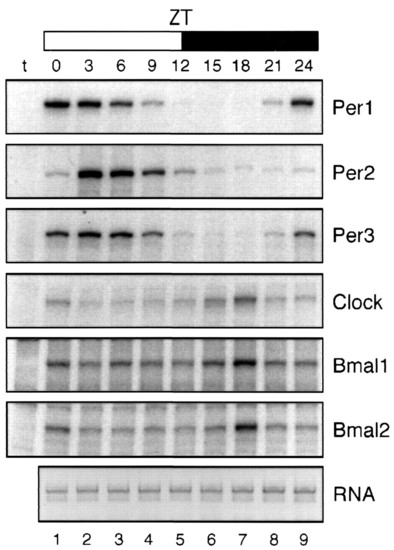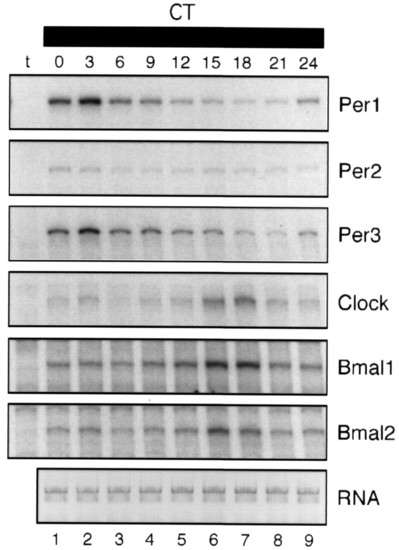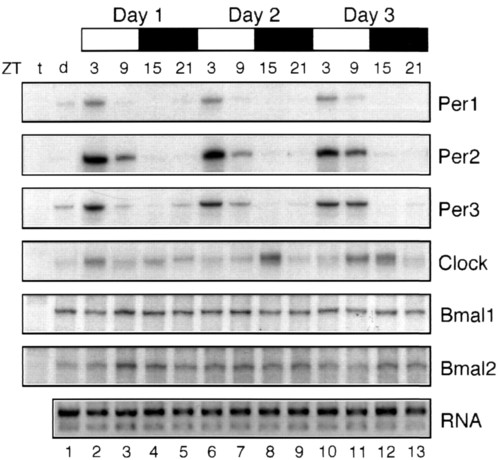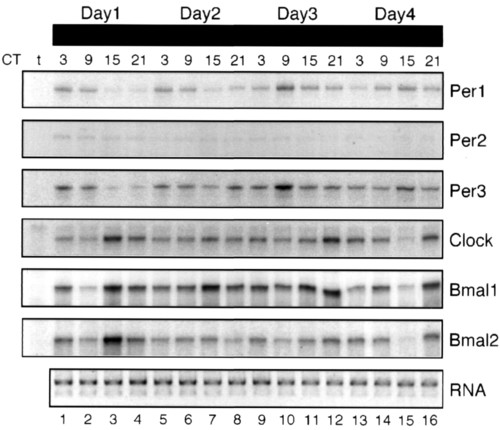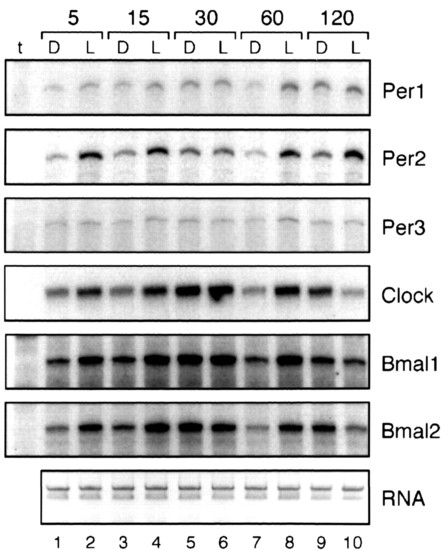- Title
-
A cell-based system that recapitulates the dynamic light-dependent regulation of the vertebrate clock
- Authors
- Pando, M.P., Pinchak, A.B., Cermakian, N., and Sassone-Corsi, P.
- Source
- Full text @ Proc. Natl. Acad. Sci. USA
|
Oscillation of clock components under a LD cycle. RNase protection analysis of Per1, Per2, Per3, Clock, Bmal1, and Bmal2 gene expression in Z3 cells entrained for 5 days under a 12:12 LD cycle. RNA was harvested at the indicated ZTs during day 6 of the LD cycle. The bar above indicates light (white) and dark (black) periods. tRNA serves as a negative control reaction (t). Relative amounts of total RNA used for each sample are displayed (RNA). The ZT0 and ZT24 represent two independent samples that were harvested at the represented dark to light transition points. |
|
Oscillation of clock components under a DD cycle. RNase protection analysis of Per1, Per2, Per3, Clock, Bmal1, and Bmal2 gene expression in Z3 cells entrained for 5 days under a 12:12 LD cycle and then placed in constant darkness. RNA was harvested at the indicated CTs during the first full day of a DD cycle. The bar above indicates the DD (black) period. tRNA serves as a negative control reaction (t). Relative amounts of total RNA used for each sample are displayed (RNA). |
|
Entrainment of naive Z3 cells to a LD cycle. RNase protection analysis of Per1, Per2, Per3, Clock, Bmal1, and Bmal2 gene expression in Z3 cells maintained in constant darkness and never before exposed to a LD cycle. Naive cells were exposed to a 12:12 LD cycle, and RNA was harvested at ZT3, 9, 15, and 21. A flask of cells, synchronously prepared with the experimental samples, was continuously maintained in total darkness and harvested at the same time as the ZT3 sample of day 1, representing our dark control (d). The bar above indicates light (white) and dark (black) periods. tRNA serves as our negative control reaction (t). Relative amounts of total RNA used for each sample are displayed (RNA). |
|
Duration of circadian oscillation in constant darkness. RNase protection analysis of Per1, Per2, Per3, Clock, Bmal1, and Bmal2 gene expression in Z3 cells entrained for 5 days under a 12:12 LD cycle and the placed in constant darkness. RNA was harvested at the indicated CTs for a period of 4 days. The bar above indicates the dark (black) period. tRNA serves as our negative control reaction (t). Relative amounts of total RNA used for each sample are displayed (RNA). |
|
Entrainment of Z3 cells to an alternate LD cycle. RNase protection analysis of Per1, Per2, Per3, Clock, Bmal1, and Bmal2 gene expression in Z3 cells entrained for 5 days under a 12:12 LD cycle. After day 5 of entrainment, the LD cycle was inverted causing a 12-h extension of the dark phase. RNA was harvested at the indicated ZTs. The bar above indicates light (white) and dark (black) periods. tRNA serves as a negative control reaction (t). Relative amounts of total RNA used for each sample are displayed (RNA). |
|
Light induces gene expression during the subjective night. RNase protection analysis of Per1, Per2, Per3, Clock, Bmal1, and Bmal2 gene expression in Z3 cells entrained for 5 days under a 12:12 LD cycle and then given a light pulse. The light pulse began at ZT16 and lasted for 5, 15, 30, 60, and 120 min. RNA was harvested at each time point for light pulsed (L) and nonlight pulsed (D) samples. tRNA serves as a negative control reaction (t). Relative amounts of total RNA used for each sample are displayed (RNA). |

